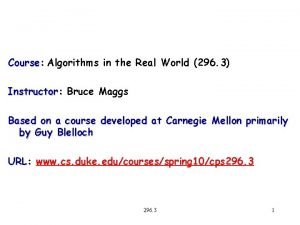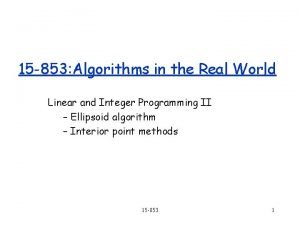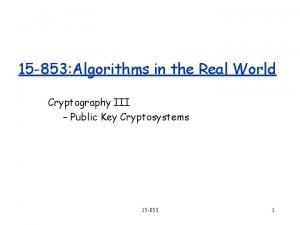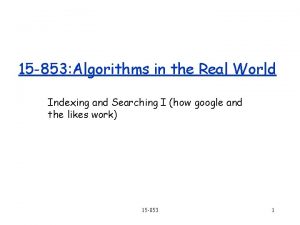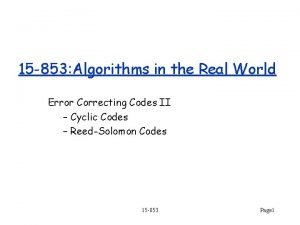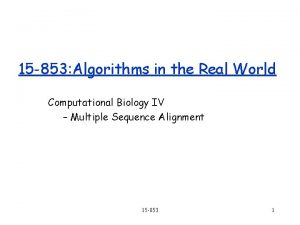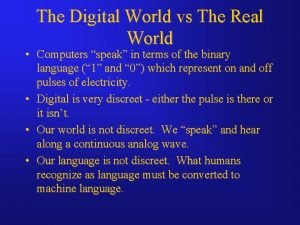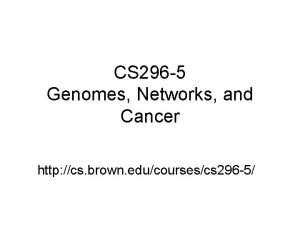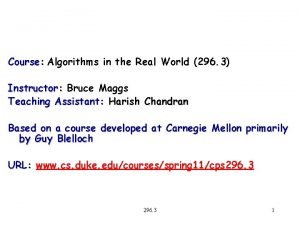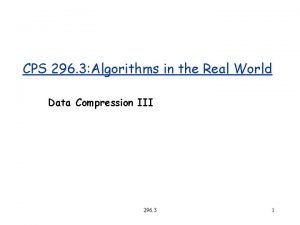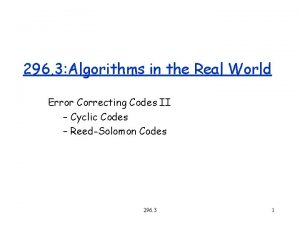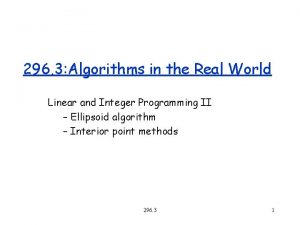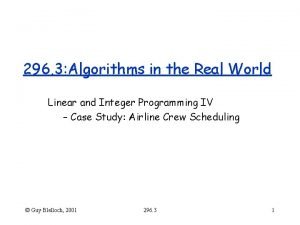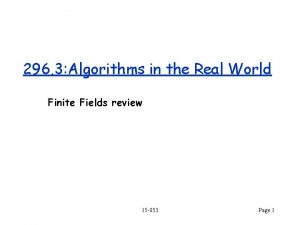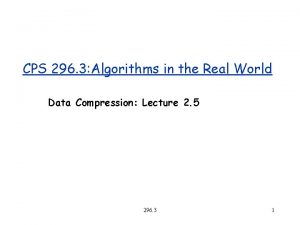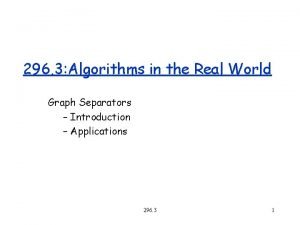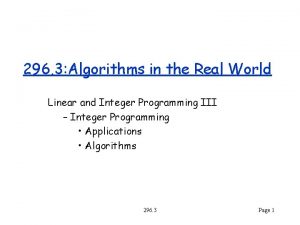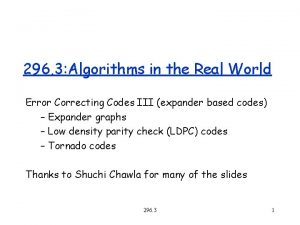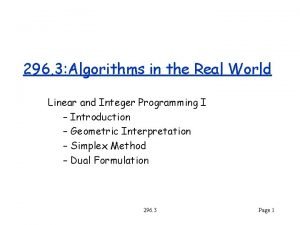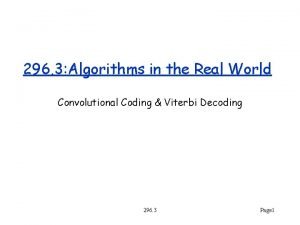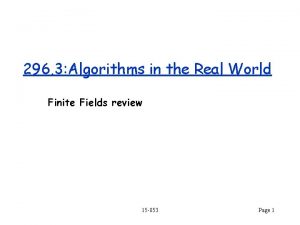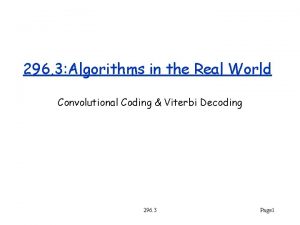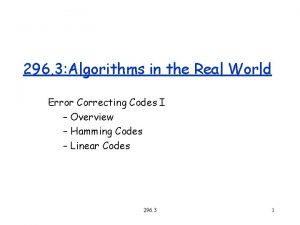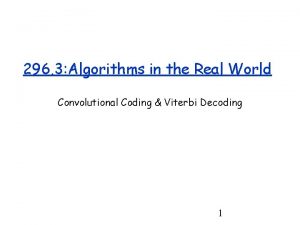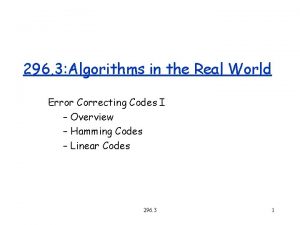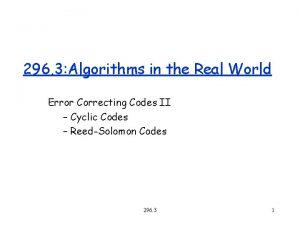Course Course Algorithms in the Real World 296



















- Slides: 19

Course: Course Algorithms in the Real World (296. 3) Instructor: Instructor Bruce Maggs Based on a course developed at Carnegie Mellon primarily by Guy Blelloch URL: URL www. cs. duke. edu/courses/spring 10/cps 296. 3 1

Expected Background Asymptotic analysis Graph Terminology and Algorithms – e. g. , what is max flow NP-complete problems and reductions Matrix algebra – e. g. , what is the null-space of a matrix Probability 296. 3 2

Course Requirements Readings – Chapters, papers, course-notes, web documents – There is NO course textbook Assignments – About 6 assignments (one will likely involve programming) Midterm and Final – Take home 296. 3 3

Why care about algorithms? Just about every field uses algorithms – Engineering, physical sciences, social sciences, business, medicine – Probably used more widely than calculus The level of sophistication has increased significantly in recent years Asymptotics is becoming more important – Linear programming (interior-point methods) – Factoring (number-field sieve) – … 296. 3 4

An Exercise What are the 10 most useful applications of algorithms in the “Real World” Work in groups of 2 or 3. You have 5 minutes. 296. 3 5

Some Examples Do cities use interesting algorithms for trash collection? Route. Smart Does your mailman use sophisticated algorithms to pick his routes? Geo. Route Does your janitor select the order of rooms using sophisticated algorithms? Probably not 296. 3 6

Topics (possible) Compression – LZ, BW, PPM, JPEG, MPEG Cryptography – ssh, RSA, Rijdael, kerberos, … Error Correcting Codes – Reed-Solomon, tornado-codes, CDs Graph Separators – Solving linear systems, VLSI, Shortest paths, … Linear and Integer Programming – Interior point methods, airline crew scheduling, … Web Algorithms – Searching, Google pagerank, duplicate removal, … Computational Biology/String Matching – MED, Suffix Trees, BLAST, Genome sequencing 296. 3 7

6 Standard Misconceptions about the Theory of Algorithms Or “why theory is only of limited use in the real world” Note: all the following are partially true, so to protect the innocent (and guilty) I will refrain from using names, sometimes. 296. 3 8

6: Theory is about worst-case analysis or, yes there is some average-case analysis, but it is irrelevant also. I care about my problem instances. Many solutions are of this form, but 1. understanding worst case helps understand what the bad examples are 2. there has been significant work on considering bounds given certain restrictions on data distributions 3. there has been significant work on studying what fraction of cases are hard. 296. 3 9

Side note: a hot topic Characterizing input classes or properties and analyzing algorithms for those inputs Any ideas for graphs? Any ideas for sorting? Any ideas for point distributions? 296. 3 10

5: Machine model used to analyze algorithms is broken because it does not account for locality. Yes the RAM is not a perfect model, but 1. there are many results using various enhancements to the model (IO, cache, streaming). If you care about more accurate costs, consider results for these models. 2. most results do not change qualitatively across models. P vs. NP translates across most models 3. many great ideas come from simplified models that are later translated to more sophisticated models 296. 3 11

4: Theory is about Runtime Analysis No, theory is about formalizing models. Consider 1. cryptography • what does it mean to be hard to break? – what is a public-key cryptosystem? – what is a zero-knowledge proof? 2. learning theory 3. information theory 4. graph theory 296. 3 12

3: Most problems studied in theory are irrelevant Today’s irrelevant problem might be tomorrow’s multibillion-dollar industry. I mean, who cares about factoring numbers, or about Galois Fields, or about expander graphs? 296. 3 13

2: Problems that are not irrelevant are oversimplified Sometimes, but 1. solving a simplified version is often a step on the way to solving the full version. 2. solving a simplified version can help understand why the full version is hard 296. 3 14

1: Theory is all about big-O and ignores constant factors Many important results do use big-O analysis, but 1. There are many results that use exact analysis, sometimes just in highest-order term, e. g. 7 n + O(log n) 2. Often algorithms with large constant factors are later improved, sometimes with trivial modifications 3. Sometimes the large constant factor is just in the proof (perhaps to simplify it), and not in the real algorithm. 296. 3 15

On Strassen’s Matrix Multiply From Numerical Recipes (Press et. al. 1986) “We close the chapter with a little entertainment, a bit of algorithmic prestidigitation and later in the same section “This is fun, but let’s look at practicabilities: If you estimate how large N has to be before the difference between exponent 3 and exponent 2. 807 is substantial enough to outweigh the bookkeeping overhead, arising from the complicated nature of the recursive Strassen algorithm, you will find that LU decomposition is in no immediate danger of coming obsolete. ” 296. 3 16

From an Experimental Paper From an experimental paper (Bailey, Lee and Simon): “For many years it was thought that [the level at which Strassen’s algorithm is more efficient] was well over 1000 x 1000. In fact, for some new workstations, such as the Sun-4 and SGI IRIS 4 D, Strassen is faster for matrices as small as 16 x 16. Most modern matrix libraries now supply Strassen as a choice – IBM ESSL library – Cray Libraries – LAPACK library 296. 3 17

What each topic will cover Key problems in the area – Formal definitions – How they relate to practice Many algorithms – Theory – Practice Key applications along with case studies 296. 3 18

Some General Themes Measures of “performance” beyond “Time” – Quality of results – Generality – Simplicity Transition from theory to practice – Often an iterative process Characterizing input – Input data is rarely “worst case” or even “expected case” when the expectation is over all possible inputs. 296. 3 19
 Algorithms in the real world
Algorithms in the real world 15-853 algorithms in the real world
15-853 algorithms in the real world Real world cryptography
Real world cryptography 15-853 algorithms in the real world
15-853 algorithms in the real world Xv-853
Xv-853 15-853 algorithms in the real world
15-853 algorithms in the real world Real world polynomial function in real life
Real world polynomial function in real life Real world vs digital world
Real world vs digital world The real world is the world of ideas
The real world is the world of ideas Wac 296-155
Wac 296-155 Wac 296-800-160
Wac 296-800-160 Wac 296 305
Wac 296 305 Nnpj-296
Nnpj-296 Sos mihai bravu 296
Sos mihai bravu 296 Wac 296-305
Wac 296-305 E-296
E-296 Wac 296
Wac 296 Wac 296-307
Wac 296-307 Cs 296
Cs 296 Hát kết hợp bộ gõ cơ thể
Hát kết hợp bộ gõ cơ thể
